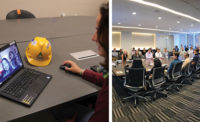Legacy Award | Leadership Profile
Polhamus Fosters Future Leaders

Joyce Polhamus has helped elevate a once undervalued health care interiors market since the early days of a 40-plus-year career.
Photo courtesy of SmithGroup
During her 40-plus-year career, Joyce Polhamus has elevated a once undervalued health care interiors market to a critical component of design in support of contemporary patient care. Additionally, a passion for senior well-being has helped expand design opportunities in the often overlooked senior living market. But her contributions as a leader—fostering the next generation of design professionals—may ultimately be her lasting accomplishment. A 27-year employee of SmithGroup, where she is currently office director for the San Francisco, Sacramento and Portland, Ore., offices, she has supported and guided the careers of hundreds of staff members. In light of her contributions to the design community in business pursuits and professional development, ENR California named Joyce Polhamus its 2023 Legacy Award recipient.

Joyce Polhamus, second from right, promotes breaking down silos and advocates for cross-studio collaboration.
Photo courtesy of SmithGroup
Problem Solver
From her days at University of California, Berkeley, where she earned a bachelor’s degree in architecture, to her first job at managed care giant Kaiser Permanente, Polhamus viewed architecture as a way to solve problems. “I wasn’t introduced to it as a designer,” she recalls. “I’ve never been a visionary design person. I have visions of how things should be.”
That outlook opened opportunities for Polhamus in a health care market that she says many designers viewed as “dull and institutional.” As the company’s second interior designer, she emphasized the importance of interior environments in health care at a time when the focus was on medical intervention. “Others wanted to do high-end design, so I got to float around in this little world and stay under the radar,” she says.
Her work grabbed the attention of HOK, who hired her to assist on a hospital project in Anchorage because the firm “didn’t really do hospitals” at the time. Although she was only four years into her career, Polhamus was seen as an expert. “It really built up my confidence,” she says. “The client would comment on my knowledge of the terminology from meeting with all of the users and doing data sheets on every single room.”
After three years on the project, however, Polhamus saw a dearth of health care work at the firm and was shifted over to commercial interiors. To keep her interest in health care active, she formed a health care focus group at HOK. “We met every week,” she says. “We were really trying to build something.”

Motion Picture and Television Fund’s 40-acre campus features design concepts focused on “aging in place.”
Photo by David Wakely Photography, courtesy of SmithGroup
Commitment to Seniors
Although health care was her passion, an opportunity to work on a senior living project in Tokyo further honed her focus. “That’s when I had an epiphany,” she says. “People spend more time in a senior living environment than in a hospital. I saw senior living as where I could have a bigger impact and make a difference.”
While hospitals and health care facilities focused primarily on short-term care, Polhamus found that senior living presented longer-term challenges. From building circulation that encourages movement through the facilities to furniture selections that were easy to get in and out of, Polhamus dug in on dozens of design considerations that would improve quality of life. “It’s all about giving seniors or people in skilled nursing the dignity that allows them to be as independent as possible for as long as possible,” she says.
“I’ve never been a visionary design person. I have visions of how things should be.”
—Joyce Polhamus, SmithGroup
After a few more years at HOK, Polhamus took her talents to SmithGroup. As a project manager, she built a diverse portfolio, but says her health care and senior living work remain some of the most meaningful ones. Notable projects include master planning and design for the Motion Picture and Television Fund’s 40-acre campus, which promoted concepts of “aging in place” and emphasized community, social interactions and independence.
Other work includes Shanghai Jade Tower, which was SmithGroup’s first high-end continuing care retirement community in China and one that introduced new concepts in senior living to the country. Her work on the Trousdale Assisted Living and Memory Care project in Burlingame, Calif., reaped an AIA national award in 2019.
As her project achievements accumulated, her interest in developing as a leader in the firm also emerged. When SmithGroup decided to launch a health care interiors group in 2004, Polhamus says she “gathered up her courage” and presented herself as a potential candidate. “It was a big bold scary move for me, but I was willing to take the risk because I remember thinking, if they don’t want me to do it, then at least I know I don’t have a future at SmithGroup,” she says.
The move paid off and Polhamus got the promotion, setting her on her current leadership path with SmithGroup. Her pivot to leadership gave her a chance to take on new challenges that extend well beyond projects. Polhamus saw opportunities to rethink office culture, specifically working toward breaking down silos, advocating for more cross-studio collaboration and encouraging transparency.
Polhamus specifically recalls an early incident where the health care studio chose to use an outside firm for a project rather than an internal team. “All I could think was ‘game on,’” she says. “That’s when I learned that I have to stand up to these guys because it wasn’t just about me. I have to stand up for all of us now.”
Tearing down silos was a significant part of that strategy. “When I started, people had their own silos and it was very competitive,” she says. “People would sit in meetings with their arms crossed. If they didn’t have work for you, you were let go versus sharing work and keeping everyone engaged.”

Shanghai Jade Tower was SmithGroup’s first high-end continuing care retirement community in China and introduced new concepts in senior living to the country.
Photo by Seth Powers, courtesy of SmithGroup
Leader for Change
In 2012, Polhamus was named health care studio leader, followed by a promotion to office director in 2015. Today, she leads more than $100 million in annual revenue and is responsible for about 200 staff members in San Francisco, Sacramento and Portland. In her role, she has been able to rethink office structure and processes. During that time, “everyone’s world has gotten bigger,” Polhamus says, as her office regularly works alongside staff from other offices on projects. The days of cross-armed meetings have been replaced with transparent and collaborative sessions that welcome input and outreach. “It’s a good vibe,” she says. “We totally support each other. You don’t have to fight to get the resources and expertise you need. If there’s an opportunity, people come running.”
Jim Benney, chief nurse executive and vice president of surgical and interventional services at Sutter Health, says that he has seen that sense of teamwork in person, including a time when his team co-located with SmithGroup on a project. “You can see that Joyce is very collaborative, very team focused and very focused on the wellness of her employees,” he recalls. “You can tell that she mentors and fosters growth, helping people grow in their practice and making sure there are opportunities for people to continue through their careers.… She’s not a boss. She’s not a manager. She’s a leader.”
One notable accomplishment during her tenure is that the San Francisco office features an all-female studio leadership team. As someone who has faced sexism and stereotypes throughout her career, Polhamus is committed to empowering women to pursue their own passions.
Although firm in her beliefs, Polhamus is a consummate and gracious professional, says Rona Rothenberg, a former client with multiple public and private entities. “She is not only smart and experienced, she has the temperament for leadership,” she says. “She never struck me as a queen bee. You see a lot of people who adopt a tough persona and make it all about themselves. She was never like that.”

Polhamus pictured at the opening of Shanghai Jade Tower.
Photo courtesy of SmithGroup
Fostering the Next Generation
The senior living sector remains a passion for Polhamus, and she aims to use her position to create the next generation of leaders of those studios. “I want to see senior living [studios] in more offices,” she says. “I think a lot of staff will appreciate that we’re making spaces in our communities that are good places for people to age gracefully. It’s about giving back. People feel good about that.”
Alexis Denton, principal at Resilient Environment, credits Polhamus with sparking her interest in senior living. When Denton joined SmithGroup after college in 2003, Polhamus mentored her and introduced her to opportunities in the sector. “Here I was, a 22-year-old kid, and she was taking me to conferences and making me a partner in business development and marketing,” she recalls. “She introduced me to the whole community, took me under her wing and treated me, not like a 22-year-old, but a partner.”
“She’s not a boss. She’s not a manager. She’s a leader.”
—Jim Benney, Sutter Health
Polhamus asked Denton at age 33 to lead senior living in the San Francisco office. By 35, she became a principal. “She treats everyone, regardless of their age, as a peer, and I think that’s pretty rare,” Denton adds.
Even after she is ready to walk away from architecture, Polhamus says she will continue to follow her commitment to senior living. She hopes to launch a venture that will house dogs with people in senior living facilities. She and her staff would handle feeding, walking and other care for the dogs, allowing seniors to simply enjoy the companionship. “It’s just so wonderful to have that dog sit on their lap, be their companion and give each other love in their final days,” she says.
Until then, Polhamus says she will continue to push for meeting senior living needs through better design. “Senior living is the one industry that hasn’t had a makeover,” she says. “Hospitality has been made over a couple of times. Office environments have been made over a couple of times. The industry wants change, and architects can be the ones to lead it.”




